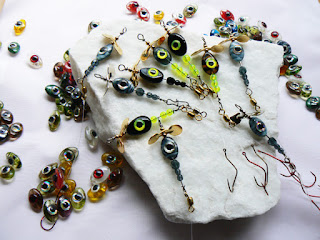I know a woman, she'll make a freight train moan.
She combs her hair, with Catfish bones.
Ray Wylie Hubbard - Weevils.
Whew, it's been awhile since the last blog post. This season I took a break from pushing wholesale spinners and let the online business have it's course.
After seeing Ray Wylie Hubbard on Letterman earlier in the year, I've been listening to some of his CD's. Remembering his 'Redneck Mother' tune on a Jerry Jeff Walker tape, I realized I hadn't heard much of his other work.
Time and Inspiration, is the mother of invention.
Got a Fitbit and lost 35 pounds - walking, jogging and tracking steps.
Next, I decided I needed to develop my musical talent learning to play guitar. I now have 2 resonators, one acoustic 4 string bass and a 6 string electric dobro (plus a Fender lap slide, but who's counting).
Here's the Dobro in it's stand
Now I've got some new Noise on the Line - amp line that is!
 |
| Noise on the Line Resonator |
Anyways, while listening to Hubbard lyrics, I centered in on the catfish bones verse and decided to give my guitar avoidance and 'weight loss and gain it back again', a break to make some catfish bone combs.
First you need a woman to make them for.
Then you need a Catfish (plus a Red Snapper for a bone quality check and more servings)
 |
| Fish bone combs in waiting |
Fillet the fish and make lunch -
Then it gets complicated.
Fleshing the carcass down to bone has options.
If you do some google searches on cleaning fish bones, you learn about flesh eating beetles, leaving fish on anthills, and how oily and fragile fish skeleton's can be if you try to boil them.
Being out of flesh eating beetles, I opted to let them sun dry a few days, attracting flies and wasps and then spent an hour or so scissoring off the fish jerky between the backbone vertebrae.
Next, I did a soak in Acetone solvent to separate fatty oils and loosen up connecting tissue. Acetone worked pretty good and got inside the backbone to loosen up nerve strings and tissue in the spinal column, that beforehand, had been like iron re-enforcing rods in concrete.
After the Acetone bath and some dry scrapping, I decided to 'simmer' them in luke warm water for a few hours. Good move.
This re-hydrated and softened up the remaining jerky, and the heat separated the oil, in preparation for a more thorough scraping.
I used a sharp nosed tweezers to scrape, pick, and investigate the skeletal bone tunnels and channels. Searching for and finding a lot of hidden tissue treasure. With time, the bones were starting to get clean!
 |
| Fish bones in Acetone bath |
With the bone preparation about complete, I had to figure out how to cast handles.
I wanted clear resin, so I found Encapso K and Epoxacast on Smooth-on. Well initially I found a Water Clear product, but following that rabbit trail, it turned into a rat hole that required about $300 of new vacuum chambers and pumps to get the bubbles out, plus platinum core mold resin. Youtube has oodles of info on casting and mold making, btw.
Vacuum pumps and chambers, maybe down the road, but not today.
So clear handles to seat half the bone, leaving one side outside as the comb teeth.
I collected a bunch of smooth agates and egg shaped rock, a couple summers ago, on the shore of Lake Superior, up close to Copper Harbor, Michigan.
Loved those rocks, so they became the first models to cast in the tin core Mold Max T 15 I also bought from Smooth-on.
 |
| Mold box candidates? |
Since it was clear resin, I also dug up some multi-colored beach glass chips to spice up the cured bone profile.
Here's a look at the V1 cured molds.
 |
| Cured Molds for casting Fish bone combs |
Finally, after cure, some fish bone swag and other primitive art, plus plenty of lessons learned for Round 2!
.jpg) |
| Fish Bone combs - Hair Picks - and Sea Glass spiced Rocks |
Got some sweet Petri coaster designs out of the project too.
 |
| Green Beach Glass 60mm petri dish whatchamacallit |
 |
| Aspen mosaic coaster in 100mm glass Petri Dish |
 |
| Cape Brenton Beach Glass Desk thingee in 60mm Petri dish |











































